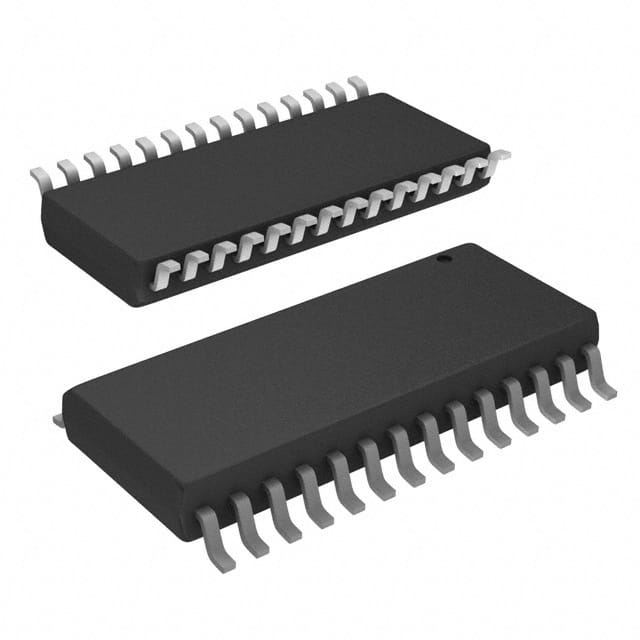AT28BV64B-25SI
Product Overview
Category
AT28BV64B-25SI belongs to the category of non-volatile memory devices.
Use
It is primarily used for storing and retrieving data in electronic systems.
Characteristics
- Non-volatile: The data stored in AT28BV64B-25SI is retained even when power is removed.
- High capacity: It has a storage capacity of 64 kilobits (8 kilobytes).
- Fast access time: The device offers a fast access time of 250 nanoseconds.
- Low power consumption: AT28BV64B-25SI operates on low power, making it suitable for battery-powered devices.
Package
The AT28BV64B-25SI is available in a small outline integrated circuit (SOIC) package.
Essence
The essence of AT28BV64B-25SI lies in its ability to provide reliable and non-volatile data storage in various electronic applications.
Packaging/Quantity
The device is typically packaged in reels or tubes, with each reel or tube containing a specific quantity of AT28BV64B-25SI chips.
Specifications
- Memory Type: EEPROM (Electrically Erasable Programmable Read-Only Memory)
- Organization: 8K x 8 bits
- Supply Voltage: 2.7V - 3.6V
- Operating Temperature Range: -40°C to +85°C
- Data Retention: 10 years
- Endurance: 100,000 write cycles
Detailed Pin Configuration
The AT28BV64B-25SI has a total of 28 pins. Here is the detailed pin configuration:
- A0 - Address Input
- A1 - Address Input
- A2 - Address Input
- A3 - Address Input
- A4 - Address Input
- A5 - Address Input
- A6 - Address Input
- A7 - Address Input
- VCC - Power Supply
- CE - Chip Enable
- OE - Output Enable
- WE - Write Enable
- I/O0 - Data Input/Output
- I/O1 - Data Input/Output
- I/O2 - Data Input/Output
- I/O3 - Data Input/Output
- I/O4 - Data Input/Output
- I/O5 - Data Input/Output
- I/O6 - Data Input/Output
- I/O7 - Data Input/Output
- NC - No Connection
- GND - Ground
- NC - No Connection
- NC - No Connection
- NC - No Connection
- NC - No Connection
- NC - No Connection
- NC - No Connection
Functional Features
- Byte-wise Read and Write: AT28BV64B-25SI allows reading and writing data in individual bytes.
- Page Write Mode: It supports fast programming of up to 32 bytes at a time.
- Software Data Protection: The device provides software-controlled protection against accidental erasure or modification of data.
- Hardware Data Protection: AT28BV64B-25SI features a hardware protection pin that can be used to prevent any write or erase operations.
Advantages and Disadvantages
Advantages
- Non-volatile memory ensures data retention even during power loss.
- High storage capacity for various applications.
- Fast access time enables quick data retrieval.
- Low power consumption extends battery life in portable devices.
Disadvantages
- Limited endurance compared to other types of memory.
- Relatively higher cost per bit compared to volatile memory.
Working Principles
AT28BV64B-25SI is based on EEPROM technology, which allows for electrically erasing and reprogramming data. It utilizes a grid of floating-gate transistors to store information. When data needs to be written, the appropriate address is selected, and the desired data is applied to the input pins. The device then uses electrical signals to modify the charge stored in the floating gates, effectively programming the data. Reading data involves selecting the desired address and enabling the output pins to retrieve the stored information.
Detailed Application Field Plans
AT28BV64B-25SI finds applications in various electronic systems, including but not limited to: - Embedded systems - Consumer electronics - Automotive electronics - Industrial control systems - Medical devices
Detailed and Complete Alternative Models
Some alternative models that offer similar functionality to AT28BV64B-25SI are: - AT28C64B-25SI: Similar specifications with a different package type. - AT28HC64B-25SI: High-speed version with faster access time. - AT28LV64B-25SI: Low-voltage variant suitable for specific power requirements.
These
Senaraikan 10 soalan dan jawapan biasa yang berkaitan dengan aplikasi AT28BV64B-25SI dalam penyelesaian teknikal
Sure! Here are 10 common questions and answers related to the application of AT28BV64B-25SI in technical solutions:
Q: What is the AT28BV64B-25SI? A: The AT28BV64B-25SI is a 64-kilobit (8K x 8) electrically erasable programmable read-only memory (EEPROM) with a 2.7V to 3.6V operating voltage range.
Q: What are the key features of the AT28BV64B-25SI? A: Some key features include a high-speed operation, low-power consumption, byte and page-level write operations, and a wide operating voltage range.
Q: How can the AT28BV64B-25SI be used in technical solutions? A: It can be used for storing program code, configuration data, or other non-volatile information in various electronic devices such as microcontrollers, embedded systems, and industrial control systems.
Q: What is the maximum operating frequency of the AT28BV64B-25SI? A: The maximum operating frequency is 25 MHz.
Q: Can the AT28BV64B-25SI be reprogrammed multiple times? A: Yes, it can be electrically erased and reprogrammed multiple times.
Q: What is the endurance of the AT28BV64B-25SI? A: It has a minimum endurance of 100,000 erase/write cycles.
Q: Does the AT28BV64B-25SI require an external power supply? A: Yes, it requires a separate power supply within the specified voltage range.
Q: What is the typical access time of the AT28BV64B-25SI? A: The typical access time is 90 ns.
Q: Can the AT28BV64B-25SI operate in a wide temperature range? A: Yes, it can operate in a temperature range of -40°C to +85°C.
Q: Are there any specific programming requirements for the AT28BV64B-25SI? A: Yes, it requires a specific programming algorithm and voltage levels to ensure proper operation and data integrity.
Please note that these answers are general and may vary depending on the specific application and requirements. It's always recommended to refer to the datasheet or consult the manufacturer for detailed information.


